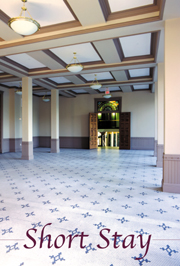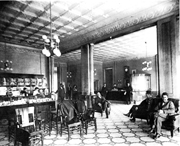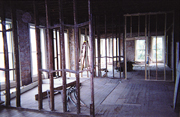

Although any of these would have been a job in itself for any one project, the constructors involved in this renovation and re-building of an entire city block of downtown Wichita all concur that the major challenge was the grueling time schedule.
"Demolition on the project started in January 2000, and had to be entirely completed for tenant move-in by Christmas of the same year," says Roger Roper, president of Dynamic Drywall Inc., of Wichita, Kan., the wall and ceiling contractor on the job.
Dynamic Drywall's involvement on the project was extensive. In the renovated sections it included framing interior walls with light-gauge metal, installing insulation, hanging and finishing drywall, the installation of plywood subfloors, application of lightweight gypsum concrete flooring, and installation of a limited amount of acoustic ceilings. On the new Tower Annex construction, its role was expanded to include structural metal stud framing, plywood roof decking and exterior sheathing.
"The large amount of demolition work and structural improvements had to be completed before we could even start our part of the job," says Roper. "Then we had to allow time for them to come in and do the rest of the pretties afterwards--the trim, paint, carpeting, etc. That meant our actual time on site was limited to about six months."

Please make up my room now
By any measure, the project was ambitious, especially given its construction schedule. Its goal was to provide modern apartment and retail space in an entire city block area of downtown Wichita while preserving one of the city's most historic landmarks.First opened on Dec. 31, 1889, with construction costs of $120,000, the Eaton Hotel, then named the Carey Hotel, was touted as the most elegant hotel in the Plains states. By the 1990s, however, the hotel had fallen into complete disrepair, and was much more of a tenement for the down-and-out than the luxury accommodations for the well-heeled. It was abandoned and deteriorating when it was taken over by the city of Wichita.
The city, which backed the $15 million project with around $7 million from city-issued tax-exempt bonds, then became the biggest backer of the rebuilding of what is now known as the Eaton Block. The Block includes the existing hotel--which is listed on the Wichita and national registers of historic places--and adjoining buildings, and the new six-story Tower Annex, connected to the hotel via an enclosed walkway.
The result is impressive: A mixed-use, mixed-income property that contains six structures, 115 housing units (including 26 affordable units) and more than 112,000 square feet of residential and commercial space.

Old and new
Renovation began with extensive demolition work. The Eaton Hotel had to be completely gutted, with the bottom floor turned into retail space, and the upper five floors into modern apartments. On the inside of the apartment units, everything was gutted back to the studs. They were all then re-plumbed and re-wired. New drywall was put either on the existing studs that were left between the walls of the new apartments or on the new light-gauge-steel studs within the apartment itself to form the interior partitions."We specified light-gauge metal construction mainly because the city really wanted us to do as much non-combustible new construction as possible, as well as cost considerations," says Wes Darnell, principal with the architectural firm of Wilson, Darnell and Mann in Wichita. "We left a fair amount of wood construction in place from the original construction, but where we did put new material in it was metal."
In accordance with historic renovation provisions, though, as much of the original hotel as possible had to remain intact, which resulted in some interesting features.
For instance, all of the original hotel room doors on either side of the corridors are still in place. However, since each apartment was built within the original confines of three or four of the rather small original hotel rooms, only one out of every three or four doors from the corridors actually leads into an apartment. The rest are "doors to nowhere"--drywalled over on the apartments' interiors and there only for the historic aspect they lend to the building.
Most of the walls of the two- and three-story buildings adjacent to the hotel also had to be removed so their upper floors, to be converted to apartments. Now, on the residential floors, one can walk under the roof all the way from the hotel to the Eaton Tower. The ground floor was converted into retail space, like the hotel.
Again, this made for some interesting scenarios.
"On many historic preservation projects, you may do as little as possible to get your tax credits, and leave just enough original material in place to obtain the historic classification," says Darnell. "In this case our client, and I think wisely, determined that this material had a lot of value to them as a tool for leasing and sale of the project. So we set out from the beginning to preserve as much as could potentially be saved unless it was a great financial burden on the project to save it."
In at least one case, this meant that when a building wall was removed and a sign painted on the adjacent building wall was uncovered, that sign became an integral part of that apartment's interior. In another case, decorative columns were uncovered, and that apartment's floor plan reconfigured so the columns would be part of its interior.
"The usual mind set in most developers and contractors I've worked with is to get as much old stuff out of our way as possible and build it new as much as possible," says Darnell. "In this project we went out of our way in the other direction in order to preserve the old materials so the character of the units would have a very distinct historic flavor. I think that comes through very strongly."
Of course, these changes in mid-stream can wreak havoc on an already tight schedule, which took some creative construction management.
"We broke the project up into three separate entities," says Phil Wells, with Key Construction Inc., of Wichita, the construction manager. "One was the renovation of the existing hotel, another entity was the remodeling of the two- and three-story buildings, and the third was the new construction of the tower with two levels of parking garage and four levels of apartments."
All three projects were carried out simultaneously, with many of the contractors, such as Dynamic Drywall, working on all three.
"We had crews working on the existing buildings putting in the light-gauge-steel framing and drywall, while some of our framers were working over on the new tower, doing the same thing," says Roper. "We probably had 40 to 45 guys working on the entire project at one time."
Being able to handle a multiple number of different tasks was an important consideration Key Construction took into account when it contracted with Dynamic Drywall.
"If you had one contractor's crew doing the framing and a different crew doing carpentry work and a different crew doing drywall, you've got to try to coordinate those different contractors, which could be a major challenge," says Roper. "Since they were all our crews, it was easier for us to maintain control over the construction schedule."
Once gutted, the renovation of the Eaton Hotel continued from the floor up. First, Dynamic Drywall installed a lightweight metal floor system, plywood subfloors and a lightweight gypsum concrete to form a level foundation for the rest of the framing.
The lightweight metal framing floor system--the TradeReady brand floor system--was manufactured by Dietrich Metal Framing, in Lenexa, Kan., and was supplied by Rew Materials in Wichita. The framing system was developed to permit easy installation of HVAC, plumbing and electrical with no need for hole cutting, and features pre-drilled screw holes, as well.
"The TradeReady Floor System was designed to be less time-consuming to install for framers and tradesmen, who ordinarily would spend a lot of time and money drilling and cutting wood products," says William S. Dietrich, chairman of Dietrich Industries. "In addition, since it is made of galvanized steel, it is priced to be competitive with dimensional lumber, and is less expensive than engineered wood products."
Plywood subfloors were installed over the metal floor system, and then Dynamic Drywall applied Firm-Fill Gypsum Concrete, manufactured by Hacker Industries Inc., of Newport Beach, Calif., over that.
Firm-Fill Gypsum Concrete is a cementitious floor underlayment designed for use in multi-family housing to satisfy acoustical ratings and fire codes. Since it creates smooth, level floors, it was ideal for use in the renovation.
This was important in the renovation of the century-old hotel, whose foundation had sagged more than 8 inches. Once that end was jacked into place and set, more minor leveling had to be done throughout the building.
"The original floors were in very bad shape and had to be torn up," says Nick Dennis, sales rep for Rew Materials. "A lot of work was put into getting everything level before any of the steel framing was set. So when it was time to do the steel, there wasn't much of a problem getting things to fit."
Most of the partition walls weren't a problem, since they didn't go from floor to ceiling. The rest of the light-gauge steel was easily cut to size on the job site with conventional tools, and work went smoothly once the initial leveling was done.
Meanwhile, while all this work was being done on the old hotel and existing two- and three-story buildings, crews were hard at work on the new six-story Annex Tower, immediately south of the hotel.
The Annex Tower, built to mirror the existing hotel, consists of two levels of pre-stressed concrete parking garage and four floors of apartments. Built about the same length and exactly the same height as the old hotel, it also has the same dormers on the top floors as the existing hotel. The parking garage is complementary to the hotel elevation, with window holes running down the same window lines, and then utilizing the same red brick and stone detail as the original.

Welcome guests
The structural metal studs, light-gauge metal framing and TradeReady Floor System used on the Annex Tower were once again manufactured by Dietrich and supplied by Rew Materials. Three-quarter inch plywood subfloors were covered by the Hacker Industries' Firm-Fill Gypsum Concrete product."On the Annex Tower, all the steel material--structural steel, floor joists and framing--were all ordered to size and delivered within two weeks of ordering on a floor-by-floor basis," says Dennis. "This allowed us to pre-cut everything to an incredibly accurate spec, especially when compared to wood products, which expand and contract and warp. All of this meant less hassle for contractors on the site, and speeded up the construction time."
And time was of the essence.
"Building the tower had to go like clockwork, and really had to be done by one contractor in order to get the coordination down and control the internal schedule," says Roper. "Our schedule called for only three weeks per floor to get the structure up, the floor on, and move up to the next floor. If we had to wait on any one contractor holding up the show, that would have shot the whole schedule. But as it was, we marched right up the building and had it closed in right on schedule. We were hitting those floor schedules to the day."
Dynamic Drywall worked like a well-oiled machine, putting the bearing walls up, setting the floor joists and putting the subfloor down.
"Then we're going up with another floor with a structural crew while we've got a light-gauge crew underneath framing the non-load bearing walls. As we're bringing the building up, they start roughing in below us," Roper says.
"The entire project went very smoothly," says Wells. "Everyone is pretty happy with the way it turned out, and we even got it finished two days ahead of schedule."

Report Abusive Comment